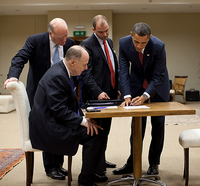Immediately following World War II, the United States undertook a complete restructuring of its foreign policy apparatus. The 1947 National Security Act redesigned the national security bureaucracy of the United States, giving birth to the Central Intelligence Agency, the Department of Defense and the United States Air Force. This redesign was necessary because the United States had taken on a global role during World War II, one that the extant bureaucratic structure was insufficient to manage. The title of Dean Acheson’s memoir of his tenure as secretary of state from 1949 to 1953, “Present at the Creation,” captured this moment perfectly: As the United States assumed a dominant global role, the machinery of its foreign relations experienced a rebirth.
At the beginning of every national security course I teach, I assign two articles, one by international relations theorist Arnold Wolfers and the other by political scientist Charles Lindblom (.pdf). Wolfers warns of the importance of clearly articulating values such as “national security” or “national interest,” and the dangers of leaving them ambiguous and poorly defined. Meanwhile, Lindblom suggests that most decisions in the real world do not involve grappling with questions of core values, but instead picking from a very few concrete policy options. The arguments conflict with one another, but illuminate a key dilemma for policymakers, who must simultaneously maintain a grip on core values while appreciating that history and the structure of our institutions provide us with only a limited number of genuine alternatives to choose from.
Most of the time, when confronted with the clear shortcomings of the system in place, we choose to muddle through. Since 1947, the United States has undertaken a series of minor revisions to the national security bureaucracy. The most significant change came with the 1986 Goldwater-Nichols Act, which affirmed the value of jointness and attempted to remedy the problems of inter-service conflict created by the National Security Act. After Sept. 11, the United States tweaked its intelligence bureaucracy by creating the position of Director of National Intelligence and the Department of Homeland Security, although these latter reforms represented more an effort to create cover for the intelligence failures associated with Sept. 11 than a genuine reform.

